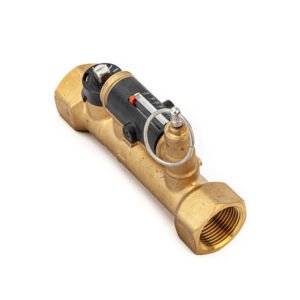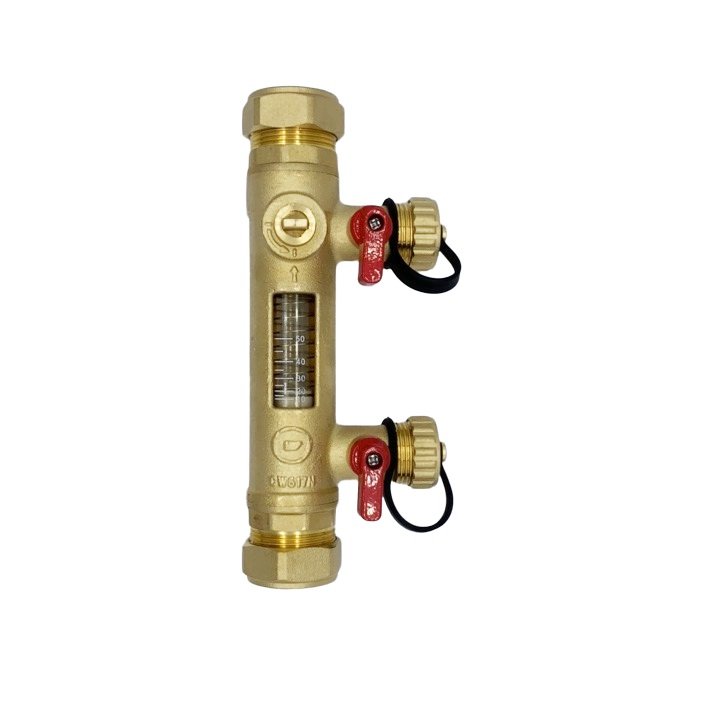
Balancing Valve with Flow meter Munufacturer
Choose HEAPE for solutions that not only meet, but exceed your expectations, driving your business forward with quality you can trust.
REQUEST A QUOTE FOR MORE DETAILS
All You Need To Know About Blancing valve with Flow meter
The balancing valve features an integrated flow meter situated in a bypass within the valve body. This flow meter is typically inactive during regular operation. It enables the direct observation of the adjusted flow rate, facilitating quick and straightforward balancing of the circuit without the necessity of connecting a manometer or differential pressure gauge.
This article provides you with everything you need to know about Balancing valve with flow meter. What you’ll learn includes the uses of balancing valves, its parts, the mechanism behind how it works and the different classifications of the Balancing valves. In the end, you can check the difference between the balancing valve and the flow meter/ setter.


Balancing valve with Flow Meter Parts
With an inline balancing flow meter, any qualified installer can set the appropriate flow for the system without costly measuring devices. The flow measurement is based on the principle of a baffle float. The flowmeter is built into the housing. The balancing can be carried out with a screwdriver at the adjusting screw. The reading position is the bottom line of the baffle float. The valve can be installed in a horizontal, vertical or inclined position. Care should be taken in order to ensure that the arrow is pointing in the direction of the flow.
1.Balancing valve
- Body–Brass
- Ball–Brass
- Ball control stem—Brass chrome plated
- Ball seat—PTFE
- Position indicator PSU
- Seals—EPDM
2.Flow Meter
- Body—Brass
- Caps—Brass
- Disc- stem Brass – chrome plated
- Spring—Stainless steel
- Seals—EPDM
- Flow meter float—PSU
- Indicator cover —PSU
General Application For Balancing Valve with Flow meter
Heating Systems: In radiators, underfloor heating systems, and other heating circuits to ensure even distribution of heat and optimal system performance.
Cooling Systems: In chilled water systems, fan coil units, and air handlers to regulate and measure the flow of the cooling medium, ensuring effective cooling distribution.
HVAC Systems in Commercial Buildings: For balancing airflow and temperature control in different zones of office buildings, shopping centers, hospitals, and schools.
District Heating and Cooling Systems: In large-scale heating and cooling networks to maintain proper flow rates and system balance.
Industrial Applications: In process cooling and heating systems to ensure precise flow control for maintaining the required temperatures in industrial processes.
Data Centers: To regulate the cooling systems that maintain optimal temperatures for servers and electronic equipment.
Residential Complexes: In multi-family housing units for balancing water flow in central heating and cooling systems.
Energy Management: Used as part of energy-efficient building designs to optimize the flow and reduce energy consumption in heating and cooling systems.

The presence of a flow meter in these balancing valves allows for precise adjustment and real-time monitoring of flow rates, which is crucial for system efficiency, performance, and maintenance. It simplifies the process of system balancing, ensuring that each part of the system receives the appropriate amount of fluid for efficient operation.
How Does Balancing Valve Work?
6. Energy Efficiency: Properly balanced systems operate more efficiently. By ensuring that no part of the system is overfed or underfed with fluid, energy consumption is optimized, leading to energy savings.
In summary, a balancing valve with a flow meter is a vital tool in HVAC and hydronic systems for achieving optimal performance and efficiency. It allows for precise flow control and easy monitoring, ensuring that the system operates smoothly and effectively.
Flow Regulation: The primary function of the balancing valve is to adjust the flow rate through a specific section of the system. This is achieved by manually setting the valve to a desired position, which changes the size of the opening through which the fluid flows, thereby controlling the flow rate.
Bypass with Flow Meter: The valve includes a bypass that houses a flow meter. During normal operation, this bypass is usually closed. However, it can be opened for the purpose of measuring flow.
Direct Reading of Flow Rate: When the bypass is opened, fluid is diverted through the flow meter. This allows for a direct reading of the flow rate in that section of the system. The flow meter typically has a gauge or dial that displays the current flow rate.
Balancing the System: By reading the flow rate at various points in the system and adjusting the balancing valves accordingly, technicians can ensure that each part of the system receives the correct amount of fluid. This is crucial for the efficient and effective operation of heating and cooling systems.
Simplification of Maintenance: The integration of a flow meter simplifies the process of system balancing. It eliminates the need for additional instruments like manometers or differential pressure gauges, making it easier and quicker to obtain accurate flow readings.
Considerations When Buying Balancing Valve with flowmeter
Flow Rate Capacity: Ensure the valve can handle the flow rate requirements of your system. The flow meter should provide accurate readings across the expected operating range.
Size and Compatibility: The valve size should match your system’s piping. Also, ensure the valve’s connection type is compatible with your existing system.
Material Quality: Choose a valve made from materials suitable for your system’s fluid and operating conditions. Materials should be durable and resistant to corrosion.
Pressure Rating: The valve should be able to withstand the maximum pressure in your system without risk of failure.
Temperature Range: Ensure the valve can operate effectively within the temperature range of your system’s fluid.
Accuracy of Flow Meter: The flow meter should provide precise and reliable readings, as this is crucial for effective system balancing.
Ease of Operation and Maintenance: Look for valves that are easy to adjust and maintain. Valves with clear, easy-to-read meters and simple adjustment mechanisms are preferable.
Certifications and Standards Compliance: Check that the valve meets relevant industry standards and certifications for quality and safety.
Brand Reputation: Opt for products from reputable manufacturers known for their quality and reliability in HVAC and plumbing products.
Cost: While cost is a consideration, it should be balanced against the valve’s quality, features, and the long-term benefits of efficient system operation.
Technical Support and Warranty: Consider the level of customer support and warranty offered by the manufacturer or supplier.
Application-Specific Features: Depending on your application, there may be additional features that are beneficial, such as valves with integrated check valves or specific designs for high-precision applications.
Different Types of Balancing valve/Flow Meter/ Flow Setter

Flow meter balancing Valve

Inline balancing flow meter

Flowsetter with Fill/Flush

Solar Flow Regulator and Flow Meter

Flow meter with compression

Fill and Flush Valve

Fill and Flush Valve

Flowsetter with Fill/Flush
REQUEST A FREE QUOTE
We'd like to work with you
Send us a message if you have any questions or request a quote. Our experts will give you a reply within 24 hours and help you select the right valve you want.
+86-576-87497198
+86-576-87497199
info@heapeflo.com

